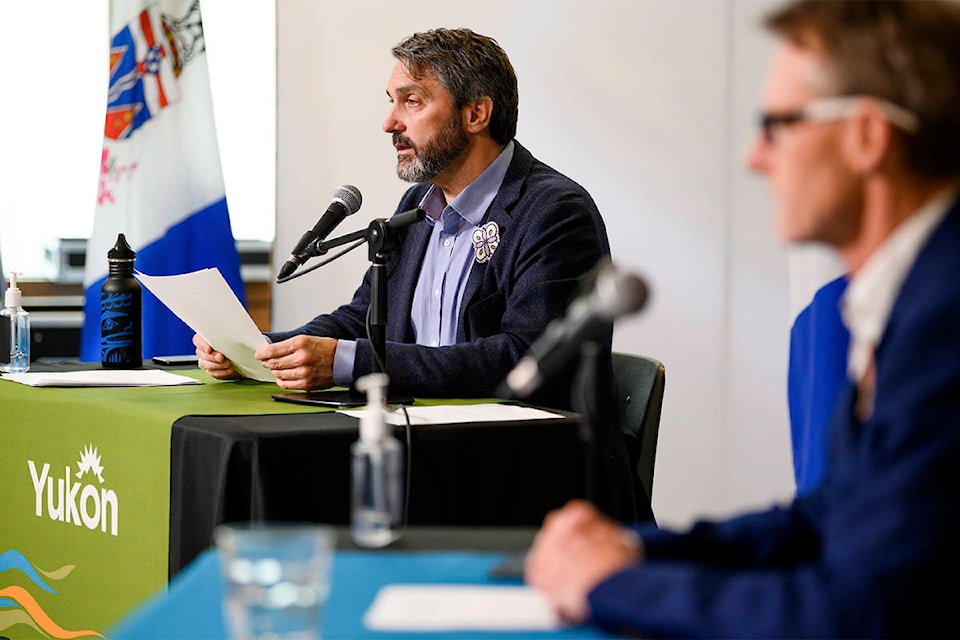Despite no new cases, the recent announcement of visitors to the Yukon testing positive for COVID-19 upon returning home was a “wake-up call” to Yukoners, according to the Yukon’s Chief Medical Officer of Health Dr. Brendan Hanley.
During a COVID-19 update the afternoon of Aug. 5, Hanley said the government saw a surge of residents coming forward to be tested after the government announced that two people tested positive for the virus after returning home from a visit to the Yukon.
Hanley noted that many were not directly related to contact tracing, but instead chose to get tested after experiencing potential COVID-19 symptoms.
“Most of the people that have come forward since Friday have been people experiencing various symptoms often for several days, rather than being specific contacts related to the exposures Friday afternoon,” he said.
Hanley acknowledged “hitches” in the testing process, and said improvements are underway.
“Overall, we have tested a lot more people in the last few days than we have in the last few weeks,” he said.
As of Aug. 5, 1,769 people have been tested in the territory.
The government confirmed that the COVID-19 case count in the Yukon remains at 14. All of the 11 people who tested positive for COVID-19 in the Yukon have recovered. The remaining three cases are Yukoners who tested positive while Outside.
Hanely said the event kicked the government’s contact tracing program into “high gear,” and acknowledged that many people had questions about the public release.
He explained that if the territory receives notice of a case, the Yukon Communicable Disease Control (YCDC) begins gathering information by contacting affected people directly.
If there is reliable information that no public exposure has taken place, due to spacing and sanitation protocols in places like at restaurants or campgrounds, specific places won’t be named.
When the YCDC has clear detail on locations and time, but not exact information on who was present and if there was public mixing, a public notification is issued. This was the case on Friday, when Integra Tire and Walmart were mentioned in a release.
In cases where there is even less information, a “last resort” broad notification is issued, like the recent notification for Dawson City.
“I know that many people have asked where these people were, names and times, but we don’t have that information to give and if we had it we would not be sharing it unless it was necessary for identification of a risk,” Hanley said.
“Posting a notification is not a reflection on the business at all,” Hanley said.
He said lessons to be taken from the incident include the need for clear directions about testing and better anticipating the surge for testing following the announcement.
Hanley said written processes and contact tracing rehearsals for cases reported in schools will be taking place prior to them reopening on Aug. 20. Hanley said early-warning systems already exist for infections like influenza.
“Obviously the earlier we know of a potential case, the sooner we can put in appropriate isolation and that will limit the impact and enable the school to continue to function as best as possible,” he said.
Individuals from outside the British Columbia, Northwest Territories and Nunavut bubble are still required to self-isolate for 14 days following their arrival in the territory.
Premier Sandy Silver said two new charges were laid this past week for violations.
“It’s not a recommendation, it is an order,” emphasized Silver. “We’ll continue to enforce the self-isolation going forward because it’s incredibly important to prevent the spread of COVID-19.”
He said over 500 complaints have been investigated so far. While most complaints focused on self-isolation violations, Silver said complaints have also come in about people transitioning through the territory and being off-course on their way to Alaska.
Changes are also on the way for infection control at the Alaskan border.
Starting Aug. 11, non-residents entering Alaska by land or air will be required to present a negative COVID-19 test done in the previous 72 hours.
Silver said U.S. officials will not be turning back people without tests at the Alaska-Yukon border into Canada, but will instead require them to pay $250 in order to complete one. They will be required to quarantine in Alaska until the test comes back negative.
“This isn’t easy. This pandemic has presented challenges to each and every one of us that is for sure,” said Silver.
In order to identify those challenges, the Yukon government, Chief Medical Officer of Health and Canadian Index of Wellbeing are launching a 30-minute survey meant to measure well-being, available here.
“This survey will measure well-being in the territory and help us understand the local impacts of COVID-19 that go beyond the usual economic indicators,” Silver said. “We want to hear directly from Yukoners about how these things are going.”
Contact Haley Ritchie at haley.ritchie@yukon-news.com
